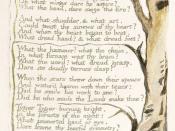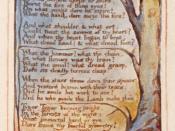The Tyger's Corruption William Blake's "The Tyger," meant to be read in conjunction with Blake's "The Lamb," tells a tale of two sides. While "The Lamb" speaks of softness and goodness, "The Tyger" tells of a powerful and evil nature. Blake asks the Tyger the question "Did he who made the Lamb make thee?"(line 20). This question represents the overall theme of the poem. How can two creations be opposite in so many ways yet related-or are they related to each other? "The Tyger" questions the truth of a two sided world and of a God that creates both good and evil.
The reader's initial reaction to "Tyger," as used in the title and in the poem, asks if the word is spelled incorrectly. Should the word be spelled Tiger? The belief that every word in a poem has a distinct purpose answers the question with a no.
Blake spells the word as "Tyger" to serve as a metaphor. "Tyger" at a most basic level represents all beasts of the world. At a more detailed level, the word represents a sharp contrast from the softness and goodness of "the Lamb." "Tyger! Tyger! burning bright / In the forests of the night, / What immortal hand or eye / Could frame thy fearful symmetry?" (Lines 1-4) Blake calls the "Tyger" twice in the beginning stanza to gain the creature's attention. The poem then offers a brief view of the creature and its setting. This view tells of the evil of this creature. "Burning bright" creates a picture of a fire and a symbol of hell. "The night" adds to the portrayal of evil. Blake then asks the "Tyger," What "immortal hand" (God) could create this "fearful symmetry?"(lines 3 and 4). This "symmetry" relates the...


